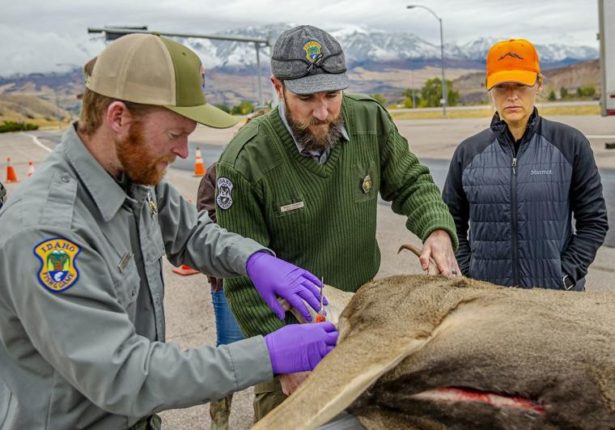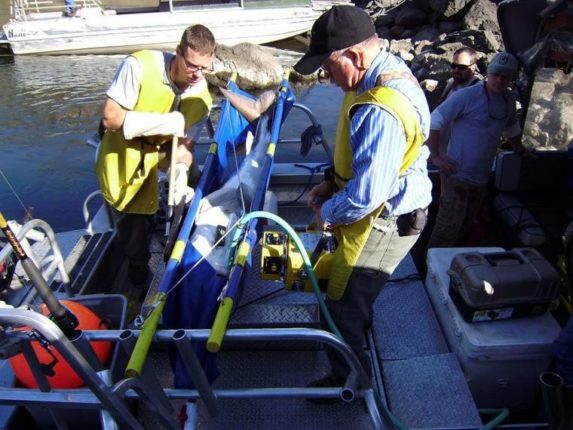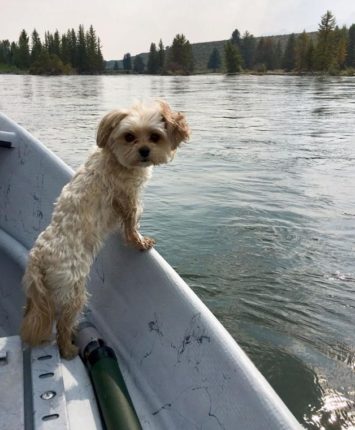JACKSON, Wyoming — Nick Lufkin’s Sunday morning started off ordinarily enough, and around 8 a.m. he let his dog Chuy out to do his business.
For the Lufkins everything was normal at their Francis Way abode north of Jackson, Wyoming, but that was quickly and tragically interrupted.
Lufkin’s son, Kai, spotted a mountain lion lingering in the yard. Soon they’d learn there was a small pride of cougars — a lioness and her two grown kittens — bunched up in their yard.
Nick Lufkin grabbed his rifle and bolted outside in hopes of recovering Chuy.
He heard a final yip from out of sight that he later learned presaged the end for the featherweight 5-pound pooch. One of the big cats had grabbed Chuy (pronounced “chewy”) by the head, quickly killing the 5-year-old Morkie (a Maltese/Yorkshire terrier cross) that had the demeanor of a bulldog. The lion stashed Chuy alongside a mostly eaten mule deer that had been cached — unknown to the family — under the deck of an outbuilding studio on Lufkin’s 3-acre lot.
“I heard a bark, and that was about it there,” Lufkin said. “He went and took on three mountain lions. It didn’t pan out for the little guy, but bless his soul because I was about to send my 13-year-old son out to rake leaves.”
Lufkin’s family remained indoors, but he soon found himself in his own precarious situation.
Running around the house to the front yard, the 20-plus-year Jackson resident, raised on a Wyoming ranch, found himself face-to-face with the cat family. The adult, he guesses, was 10 to 15 feet away, staring intently.
“I had my rifle,” Lufkin recounted, “and I yelled at them — ‘Hey!’ They did not move. … They had no fear. It was really nerve-racking.”
He blasted a warning shot into the ground near the feet of the lioness.
“It didn’t even run away,” Lufkin said. “It just turned around and then slowly walked into the tall grass. I cranked another shell in, and at this point I was going to shoot it.”
The cat family, however, had padded out of sight and would not return.
Later that morning Wyoming Game and Fish Department Warden Jon Stephens investigated and set some cage-style traps intended to take the cougars alive. That decision, Game and Fish Large Carnivore Chief Dan Thompson said, was made partly because of the dog killing, but also because of the bold behavior.
“It’s a behavior that piques our interest,” Thompson said. “We felt that, because it was a cached situation, that we had a chance to capture these animals.”
The three traps, baited with the deer remnants, were pulled the next morning untouched for fear that if they were left out they’d attract an opportunistic bear that has been making the rounds in neighborhoods near Jackson Hole Golf and Tennis Club.
Pulling the trap is a testament to the fact that humans are sharing territory with megafauna, including an array of big carnivores, in the sprawled-out subdivisions and ranches that dot the landscape between Highway 22 and Grand Teton National Park.
Coexistence is the goal, but it doesn’t always work. Bears routinely end up raiding ornamental fruit trees and getting into garbage cans. The Pinnacle Peak Pack of wolves in recent years has regularly taken advantage of the beefy bovines being reared by some of Jackson Hole’s last working ranches. And Chuy’s death is not the first time a family dog has been the casualty of lion predation in the immediate area.
“We’re not going to blame them for being in an area with deer,” Thompson said, “but we certainly don’t want to see any more dogs get killed.”
Penny Maldonado, who directs the Jackson-based Cougar Fund, urged residents to be aware of factors that could increase the chance that a lion is nearby, be it deer in their yards or decks that cats see as shelter.
“It’s a very, very difficult situation,” Maldonado said, “because there are people that are scared, and there is kind of a primal fear to living amongst wildlife.”
Lufkin is accustomed to living with wildlife and espouses tolerance of the critters they share the landscape with.
“It’s almost second nature to us,” he said. “Even my kids are very aware of it. I’ve taught my kids how to look for signs — if they see a bunch of birds move or horses in the area acting up.”
But he found the lions’ behavior this past weekend to be worrisome.
“You expect it,” Lufkin said. “But the one thing with this incident that really has me concerned is that the mountain lions didn’t show any fear toward humans.”
Chuy, who belonged to Lufkin’s daughter, Sabby, will go down in family lore as a hero, because it was his bathroom break that alerted the family to the potential danger out their back door.
“If they didn’t run from me when I fired my shot,” Lufkin said, “what would they have done to my son with a rake?”
A “mountain Morkie,” in Lufkin’s words, Chuy had the run of the neighborhood, which he could access through his dog door. Over the fuzzy pup’s five years, Lufkin said, he batted 0-for-4 when it came to tussles with wildlife. A trampling from a moose once almost did the brazen dog in, but snow evidently softened the blows. A fight with a “packrat” that made its way into the Lufkin residence didn’t go so well, and sent Chuy scampering away after a bite on his nose. A mother robin once produced the same response, Lufkin said, divebombing and “rolling” Chuy, who was pursuing the songbird’s flightless chick.
Chuy also made plenty of friends in the neighborhood, especially next-door neighbors Sally and Frank Johnson.
Sally Johnson heard a distinctive meowing from her bedroom the night before Chuy’s demise, and when Frank peered out the front door he told her he could make out what was probably “just a cat” through the darkness in a flower bed.
It was a rather big cat, they’d learn.
Because they’re frequent travelers, the Johnsons didn’t take on a new pup after their last dogs passed on, but Chuy filled part of the void by regularly wandering next door for a petting.
To avoid confusing the little fella which house was his, they wouldn’t feed him. But on Sunday morning the Johnsons attended services at St. John’s Episcopal Church, the day set for the Blessing of the Animals, and dog biscuits were being doled out.
Frank snatched up one of the snacks, with his furry neighbor friend Chuy in mind.
“We got home, and there was no dog,” Sally Johnson said. “It was sad.”




